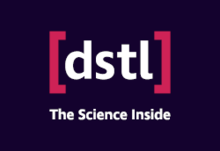Loading AI tools
U.K. Government executive agency From Wikipedia, the free encyclopedia
The Defence Science and Technology Laboratory (Dstl) is an executive agency of the Ministry of Defence of the United Kingdom. Its stated purpose is "to maximise the impact of science and technology for the defence and security of the UK".[1] The agency is headed by Paul Hollinshead as its chief executive,[2] with the board being chaired by Adrian Belton.[3] Ministerial responsibility lies with the Minister for Defence Procurement.
 | |
| Agency overview | |
|---|---|
| Formed | 2 July 2001 |
| Preceding agency | |
| Jurisdiction | United Kingdom |
| Headquarters | Porton Down, Wiltshire |
| Employees | 5,500[citation needed] |
| Agency executive |
|
| Parent agency | Ministry of Defence |
| Website | www |
Dstl was formed from the July 2001 split of the Defence Evaluation and Research Agency (DERA). Dstl was established to carry out and retain the science and technology work that is best done within government,[4] while work that could be done by industry (forming the majority of DERA's activities) was transferred to Qinetiq, a government-owned company that was later floated on the stock exchange.
Dstl absorbed the Home Office's Centre for Applied Science and Technology (CAST) in April 2018,[5] taking on CAST's role[6] to apply science and technology to support the Home Office's operations and frontline delivery, provide evidence to support policy, and perform certain regulatory functions.
Most of Dstl's funding comes from the MOD, while a small portion comes from other government departments and commercial sources. In 2016/17, 91% of Dstl's £587 million income came from the MOD.[7]
In April 2015, Dstl completed a major reorganisation, merging twelve operating departments into five divisions. The motivation behind this change was to enable more coherent and productive delivery to customers and simplify access routes for suppliers.[8]

Dstl carries out a broad range of work from high-level analysis to support Ministry of Defence policy and procurement decisions, to technical research in defence areas such as biomedical science and electronics, alongside operational work such as forensic analysis of explosives[17] and providing paid volunteer scientists to Iraq and Afghanistan to provide rapid scientific advice to British forces. It has done work for around 40 government departments and agencies including the Home Office and Department for Transport.[18] It undertakes research with both industry and academia to achieve its role.[19]
Following a review and consultation process initiated by MOD's Chief Scientific Advisor (CSA), it became responsible for the formulation and commission of MOD's non-nuclear research programme from 1 April 2010, under the responsibility of the Dstl Programme Office.[20][21] Within the Programme Office were 16 domains[22] with some established as Science and Technology Centres, including Armour and Protection, Cyber and Influence, Counter Terrorism, and CBR (Chemical, Biological and Radiological).[23] These centres fund research via the Centre for Defence Enterprise,[24] also part of the Programme Office.[25]
A subsequent MOD CSA-led review in 2015 into MOD's science and technology capability recommended that the commissioning of science and technology should be independent of the delivery.[26]
Within the Strategic Defence and Security Review 2015 was a proposal to create "a government-backed service designed to help small and medium-sized businesses bring new ideas to market more quickly".[27] In 2016, it was announced by Defence Secretary Michael Fallon that this 'Defence and Security Accelerator'[28] would have access to an £800m innovation fund and build on the 'Centre for Defence Enterprise' model, operating within Dstl.[29]
In 2017, Dstl began a five-year programme of innovation in space science.[30] In 2019, Dstl opened a new satellite ground control station at Portsdown West to support future space research.[31]
In March 2020, scientists from Dstl began supporting Public Health England to better understand COVID-19 during the COVID-19 pandemic in the United Kingdom.[32] By January 2021, around 300 scientists were said to be involved with COVID-19 support.[33]
Research Cloud (or R-Cloud) is the Dstl's supply chain marketplace for science and technology research.[34] Version 4 went live on 1 December 2020.[35] R-Cloud frameworks cover eight "capability areas":
Current sites include:[37]
The former CAST sites at Langhurst, West Sussex and Sandridge, Hertfordshire were closed around 2020 after the 2018 merger of CAST into Dstl.[5]
Sections of 150-millimetre-thick (5.9 in) pre-atomic steel plate uncontaminated with radionuclides, recovered from HMS Vanguard, were used for the shielding of the whole body monitor at the Radiobiological Research Laboratory (now Dstl) at Alverstoke, Gosport, Hampshire.[39]
In April 2005[40] the technology transfer company Ploughshare Innovations Ltd was formed to manage and exploit intellectual property within Dstl.[41] Dstl and Ploughshare Innovations have successfully spun-out several new companies including Alaska Food Diagnostics[42] and P2i Ltd.
Seamless Wikipedia browsing. On steroids.
Every time you click a link to Wikipedia, Wiktionary or Wikiquote in your browser's search results, it will show the modern Wikiwand interface.
Wikiwand extension is a five stars, simple, with minimum permission required to keep your browsing private, safe and transparent.